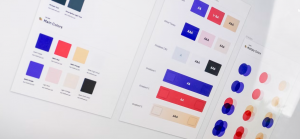Mistakes are bound to creep into your work at one point or another. They turn into a major concern when they simply cannot be excused by the viewer. Digital signage mistakes where the content becomes illegible, for instance, cause the greatest damage because the viewer can’t read the message directed at them! In hopes of helping you weed them out, we’ve compiled a long but quick-to-go-through list of digital signage mistakes! Let’s start with the design.
Cluttered and confusing design
A messy design and layout of your content can lead to confusion and prevent your message from reaching the audience. They’ll quickly give up and move on. This can be forgiven to a degree inside the store where consumers actively look for information. In that case, they’re willing to invest a little effort to find what they want. But at the storefront, you have mere seconds to engage.
This problem typically occurs when you attempt to deliver multiple messages at once. Do you try to deploy an ad, a fun message, and a call-to-action at the same time? This will only work if all three parts of the display have a clear and concise design and if the viewer is willing to invest the time to take it all in. Otherwise, they’ll glance only at one section before walking by. What’s worse, the other elements may even distract from focusing on a specific element! In this case, you’d do better to scroll through pieces of content one by one.
In short, content divisions are ideal for instances where the consumer has time to examine every piece. These divisions essentially transform the display into a data terminal. A digital menu board or a wayfinding terminal is an excellent example.
Mismatched fonts
Font choice is important and there are many excellent choices. Just ensure you’re consistent in the way you use them. Inconsistent font size or styles can be reconciled as long as they don’t present a challenge for the reader to absorb your message. Content creators often make the mistake of choosing visually appealing fonts and making them all equal or entirely random sizes, disregarding the fact that they may be difficult to read. It’s easy for you to read the content as the designer. You know it inside and out.
Ensure your main message stands out and no other text elements are in competition with it. If you’re interested in fonts, read more about them here!
Poor text quality
Incorrect usage of grammar and inaccurate spelling comes off as unprofessional. In some instances, it may come across as misleading, false, or even suspicious! This is especially the case when the brand is unknown and the viewer has no other basis on which to establish trust towards the message. Content of this sort is unlikely to impress anyone. Sadly, this is one of the more common digital signage mistakes.
This further takes us into marketing waters. When choosing which copy to highlight on your content, it’s important to choose your words carefully. Seek out short, accurate, and appealing words. We can see one example of such words in perfume ads. Instead of “smell”, they’ll use “scent”. Instead of simply describing a fragrance as “good”, they’ll opt for terms such as “captivating” or “irresistible”. Applying this principle to your message can hold immense power and influence. Adjust and re-evaluate your ad copy until you get to that sweet spot where you yourself get excited of the message.
Too much text and needless words
While we’re on the topic of text-related digital signage mistakes, try to consistently trim down as many words as you possibly can without losing the clarity and appearance of your message. There’s a reason why words such as “New arrivals!” or “Limited offer!” are so commonly used. They work!
You may include elaborative text when you know it will be read. But the main message should be clear at a glance and, once again, should never be in competition with other text next to it. Once the main message intrigues the viewer, they will examine further details of your content.
Irrelevant and outdated content
This mistake is really unforgivable in this day and age because it’s so easy to fix! Digital signage software offers many streams of content and methods of incorporating live, up-to-date information. Especially when it comes to the news or user-generated content. It’s really easy to keep things fresh and exciting!
In terms of content related to your business, don’t allow outdated sales or offers to appear anywhere. This applies to all types of signage you use, not just digital. Outdated ads and sales can cause immense damage in that the consumer will learn not to trust in your content. Once you lose their trust, any message you send their way will have less impact.
Inconsistent branding
Use color palettes which are recognizable as part of your brand image. This includes content borders, logos, text frames, etc. Naturally, be mindful of how the colors work with the environment and on the eyes. Don’t make it tacky or difficult to distinguish, no matter your brand style. Don’t write in yellow letters simply because that’s your brand. Instead find a way to incorporate those colors in a tasteful way.
By maintaining a recognizable image, consumers will steadily build an image of your brand in their minds and will know what to expect. If they see this message elsewhere, particularly on broader advertising such as billboards or online, they will recognize it faster and be more open to it! Furthermore, should other design mistakes creep in, such as a typo, it is likely the consumer will overlook it because they’ll recognize the brand.
Lack of a call-to-action
Particularly important with profit-focused campaigns and ads, a call-to-action is a key component which is sometimes left out. Creators will sometimes deploy a stunning ad which is creative and engaging, but they will not instruct the consumer what to do next.
“Visit our website,” or “Offer expires in a week! Shop now!” are simple and clear instructions to encourage the viewer to do something. Don’t be afraid to be direct in saying what you want consumers to do.
Too much movement
Digital signage draws attention to itself. You’ve surely read all about how motion makes us instinctively turn and look. But digital signage users sometimes take this to the extreme and deploy multiple active elements in their digital signage campaigns.
The frame is animated or the content has animated visuals. Then suddenly a cloud pops up in a corner. In essence, this draws attention to multiple parts of the display at once and the focus disappears. When using multiple constantly animated elements, it is better to put them in the spotlight one by one in rotation.
Neglecting the viewing angle
Keep in mind where the viewer will be when observing the display. Failing to account for this will result in poor visibility, reduced legibility, and a diminished impact. Consider the height of the display, the distance at which the display will be viewed from, and how much time the viewer will have doing so. Like so many other mistakes, this one is easily corrected through first-hand testing and getting a second opinion from another viewer. This brings us to the next mistake!
Failure to test and optimize
Testing is crucial both for the viewing angle and the actual function of the technology. It can be that a file becomes corrupted and doesn’t play. Maybe it didn’t upload right, or you have an unstable connection.
Everything should be tested at least once before launch, in particular when it comes to the appearance on the display. Colors may appear different on a specific display, making the text difficult to distinguish, or an image to become difficult to recognize. Maybe you’ll even notice the color palette clashing with the background! Test, test, test! Digital signage software will try to back you up on this and inform you if any glitches or errors occur. Keep an eye on that, too.
Lack of content variety
Ads and offers are among the most common content types for digital signage. If you find, however, that consumers are observing a display for a longer period of time, say in a waiting room, not everything can be an ad! Give content variety by balancing profit-focused content with engaging content. Keep in mind the environment of the display.
Storefront displays, just like billboards, are not observed for a long amount of time. People walk by, so there is no issue to run ads non stop on them. In other contexts, such as lobbies, waiting rooms, or long queues, constant ads eventually become less effective or even off-putting.
Missed opportunities
The last on our list of digital signage mistakes is built around inaction. There are many opportunities which significantly affect the success of your digital signage efforts. Running a strong social media strategy can produce content for digital signage, and vice-versa, giving campaigns a greater reach. Similarly, user-generated content is a well of quality content which often goes unused. There is also the matter of observing the data collected by your digital signage and adapting content to the conclusions drawn from that data.
Digital signage software provides a rainbow of uses, including apps and scheduling content in advance. Utilizing these resources makes for more consistent content, easier updates, a stronger brand image, and a more professional look, among many other things. Try it out!









